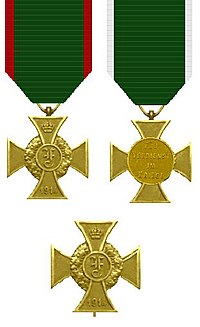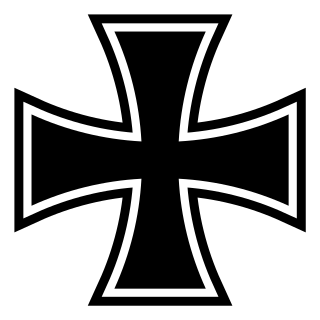
The Iron Cross is a former military decoration in the Kingdom of Prussia, and later in the German Empire (1871–1918) and Nazi Germany (1933–1945). King Frederick William III of Prussia established it on 17 March 1813 during the Napoleonic Wars. The award was backdated to the birthday of his late wife, Queen Louise. Louise was the first person to receive this decoration (posthumously). The recommissioned Iron Cross was also awarded during the Franco-Prussian War, World War I, and World War II. The Iron Cross awarded during World War II has a swastika in the center. The Iron Cross was usually a military decoration only, though there were instances awarded to civilians for performing military functions. Two such examples were Hanna Reitsch, who received the Iron Cross 2nd Class and Iron Cross 1st Class, and Melitta Schenk Gräfin von Stauffenberg, who received the Iron Cross, 2nd Class. Both were civilian test pilots during World War II.
The Grand Cross of the Iron Cross was a decoration intended for victorious generals of the Prussian Army and its allies. It was the second highest class of the Iron Cross, following the Star of the Grand Cross of the Iron Cross which was given only twice. Along with the Iron Cross 1st and 2nd Class, the Grand Cross was founded on 10 March 1813, during the Napoleonic Wars. It was renewed in 1870 for the Franco-Prussian War and again in 1914 for World War I. In 1939, when Adolf Hitler renewed the Iron Cross as a German decoration, he also renewed the Grand Cross.

The Order of the Black Eagle was the highest order of chivalry in the Kingdom of Prussia. The order was founded on 17 January 1701 by Elector Friedrich III of Brandenburg. In his Dutch exile after World War I, deposed Emperor Wilhelm II continued to award the order to his family. He made his second wife, Princess Hermine Reuss of Greiz, a Lady in the Order of the Black Eagle.
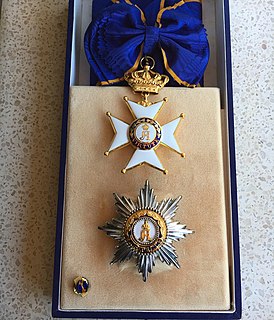
The Order of Civil and Military Merit of Adolph of Nassau is an order of merit of the Grand Duchy of Luxembourg for meritorious service to the Grand Duke, the Grand-Ducal House and Luxembourg. It was founded in 1858 as a chivalric order of the Duchy of Nassau by Adolphe of Nassau in honor of his namesake and ancestor, Adolf, Count of Nassau, the only member of the House of Nassau to have been Roman King of Germany. After the Duchy of Nassau was annexed by Prussia in 1866 and Adolphe became Grand Duke of Luxembourg in 1890, he revived the order as an order of merit.
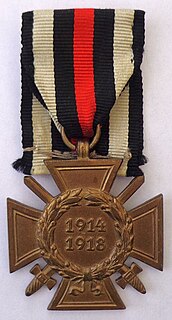
The Honour Cross of the World War 1914/1918, commonly, but incorrectly, known as the Hindenburg Cross was established by Field Marshal Paul von Hindenburg, President of the German Republic, by an order dated 13 July 1934, to commemorate service of the German people during the First World War. This was Germany's first official service medal for soldiers of Imperial Germany who had taken part in the war, and where they had since died it was also awarded to their surviving next-of-kin. Shortly after its issuance, the government of Nazi Germany declared the award as the only official service decoration of the First World War and further forbade the continued wearing of German Free Corps awards on any military or paramilitary uniform of a state or Nazi Party organization.

The House Order of Hohenzollern was a dynastic order of knighthood of the House of Hohenzollern awarded to military commissioned officers and civilians of comparable status. Associated with the various versions of the order were crosses and medals which could be awarded to lower-ranking soldiers and civilians.
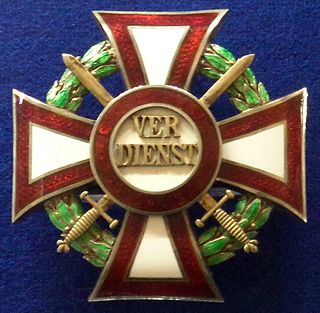
The Military Merit Cross was a decoration of the Empire of Austria and, after the establishment of the Dual Monarchy in 1867, the Empire of Austria-Hungary. It was first established on October 22, 1849 and underwent several revisions to its design and award criteria over the years of its existence. It became obsolete in 1918 with the dissolution of the Austro-Hungarian Empire.

The Military Merit Cross (Militärverdienstkreuz) was established by Friedrich Franz II, Grand Duke of Mecklenburg-Schwerin on August 5, 1848. Mecklenburg-Schwerin, a grand duchy located in northern Germany, was a member of the German Confederation and later the German Empire.

The Military Merit Medal was a military decoration of the Empire of Austria-Hungary. It was founded by Emperor Franz Joseph I on March 12, 1890. The Military Merit Medal is often referred to as the "Signum Laudis" after the inscription on the reverse of the medal.

The House and Merit Order of Duke Peter Frederick Louis or proper German Oldenburg House and Merit Order of Duke Peter Frederick Louis was a civil and military order of the Grand Duchy of Oldenburg, a member state of the German Empire. The order was founded by Grand Duke Augustus of Oldenburg on November 27, 1838, to honor his father, Peter Frederick Louis of Oldenburg. It became obsolete in 1918 after the abdication of the last grand duke.

The Military Order of Max Joseph was the highest military order of the Kingdom of Bavaria. It was founded on 1 January 1806 by Maximilian I Joseph of Bavaria, the first king of Bavaria. The order came in three classes:

The Military Merit Order (Militärverdienstorden) was a military order of the Kingdom of Württemberg, which joined the German Empire in 1871. The order was one of the older military orders of the states of the German Empire. It was founded on February 11, 1759 by Karl Eugen, Duke of Württemberg as the Militär-Carls-Orden, and was renamed the Militärverdienstorden on November 11, 1806 by King Friedrich I. The order underwent several more revisions over the course of the 19th and early 20th centuries. It became obsolete with the fall of the Württemberg monarchy in the wake of Germany's defeat in World War I.

The Military Order of St. Henry was a military order of the Kingdom of Saxony, a member state of the German Empire. The order was the oldest military order of the states of the German Empire. It was founded on October 7, 1736 by Augustus III, King of Poland and Elector of Saxony. The order underwent several more revisions over the course of the 19th and early 20th centuries. It became obsolete with the fall of the Saxon monarchy in the wake of Germany's defeat in World War I.

The Order of Merit for Science and Art was established on 30 July 1873 by Duke Friedrich I of Anhalt. It was awarded to acknowledge and reward excellent and outstanding achievements in the field of science and art at home and abroad.

The Friedrich-August Cross was a German decoration of the First World War. It was set up on 24 September 1914 by Frederick Augustus II, Grand Duke of Oldenburg, with two classes, for "all persons of military or civilian status, who have shown outstanding service during the war itself".

The War Merit Cross was a military decoration awarded by the Grand Duchy of Baden. Established 9 September 1916 by Frederick II, Grand Duke of Baden, the cross was awarded to recognize war service and voluntary work, primarily on the home-front.
The Brunswick War Merit Cross German: Braunschweigisches Kriegsverdienstkreuz) also known as the Ernst-Augustkreuz, was a military decoration of the Duchy of Brunswick. The Cross was established 23 October 1914 by Ernest Augustus, Duke of Brunswick. The cross was awarded to all ranks for distinction in war. On 20 March 1918, a first class of the Cross was created in pinback form, with the existing Cross becoming the second class. This brought the Cross in line with awards of other German States like Prussia with the Iron Cross. The cross was awarded on a blue ribbon with yellow stripes for combatants and on a yellow ribbon with blue stripes for non-combatants.
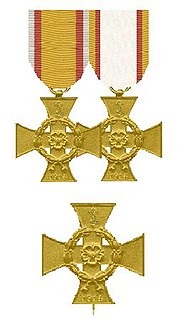
The War Merit Cross was a military decoration of the Principality of Lippe. Established on 8 December 1914, by Leopold IV, Prince of Lippe, it could be awarded to combatants and to non-combatants for significant contributions to the war effort. The cross was awarded approximately 18,000 times to combatants and 1,100 times to non-combatants.

The Cross for Merit in War was a military decoration of the Duchy of Saxe-Meiningen established by Bernhard III, Duke of Saxe-Meiningen on 7 March 1915.

The Merit Cross was a meritorious service decoration of Prussia. Established 27 January 1912, by Wilhelm II in his capacity as King of Prussia, it recognized general merit to Prussia. The cross could be awarded to civilians as well as members of the military. The cross was awarded in two classes a gold cross and a silver cross.
